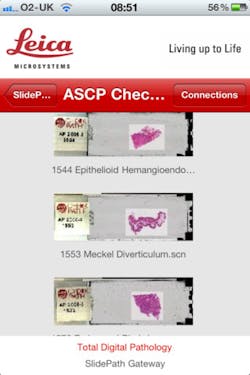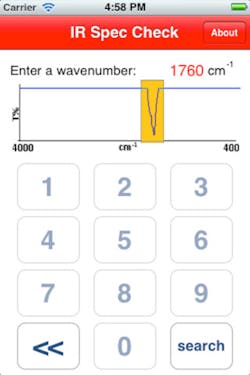
With Apple iPhones and other smartphones now making up nearly half (47.9%) of all cell-phone subscribers as of February 2012, according to a Nielsen report1, applications—or apps—for these devices in any category imaginable continue to crop up everywhere to make subscribers' lives easier. Now, biomedical companies have begun to harness the power of the app: Because researchers require access to hosts of data instantly to complement different types of optical instrumentation, it's fitting that iPhones and smartphones can aid their use.
So this installment of Product Focus will differ slightly from the rest, as it will present a roundup of some recently released apps across different disciplines that can enable researchers to boost their productivity in the lab. Angry Birds they are not, but these apps should catch on nicely in the life sciences community, at least. And to keep with today's budget-conscious times, they're all free to download.
There's an app for that
For life scientists working with optical technologies, the available apps out there span a handful of different applications, including—but not limited to—digital pathology, fluorescence imaging, spectroscopy, and optical coherence tomography (OCT). And keeping with what most apps across the board aim to offer subscribers, these apps are all intuitive—most requiring nothing more than a tap of a finger. This makes them easy enough for students to use as well.
Digital pathology—which manages imaging information gathered from a digital slide—is a natural choice for a life sciences-based app, as it can provide a database for managing such information. So, for pathologists who need remote access to whole-slide images, the SlidePath Gateway digital pathology app for iPhone from Leica Microsystems (Wetzlar, Germany; http://itunes.apple.com/ie/app/slidepath/id444440076?mt=8) provides access to images captured on the company's SCN400 slide scanner. The app also offers the images' review findings provided by institutes and other pathologists for comparison. And users can browse folders of images from each of the app's External Quality Assessment (EQA) programs, select individual cases, and view, zoom, and navigate around the slides. What's more, the app also works on Apple's iPad tablet computer.
89 North (Burlington, VT) has also introduced an iPhone app—one that assists one of its fluorescence imaging solutions. Initially designed for help with configuring the company's Heliophor pumped phosphor light engine for fluorescence imaging, the Heliophor iPhone app (http://itunes.apple.com/us/app/heliophor/id420223764?mt=8) contains an extensive spectral database of the most commonly used fluorescence probes as well as customizable filter selections that can be graphed and overlaid with specific Heliophor modules and filters. With the app, users can display a module of interest with a desired filter to determine compatibility, and can search for a desired fluorescent probe and display compatible modules. These can then be e-mailed to someone or submitted for a quote, says Chris Baumann, director of sales and marketing at 89 North. To date, >500 people have downloaded the app since its release, he says.
Recognizing that clinicians who use 3D OCT technology do not want to spend a lot of time sitting in front of their instrumentation to review images, the University of Pittsburgh (Pittsburgh, PA) created OCT Browser (http://itunes.apple.com/us/app/oct-browser/id368039317?mt=8)-an app that enables these images to be uploaded directly to their iPhones and iPads for review anywhere. Right after the technicians scan patients, they can then convert the 3D OCT images to an iPhone- and iPad-friendly format and send them to clinicians for review in less than one minute, says the university. Then, clinicians can share the images with both their colleagues and their patients. A part of the university's OCT Software Suite, the app also comes preloaded with four example 3D OCT images.
Apps for learning
Designed for both iPhone and iPad, app developer Marzloff Media created IR Spec Check (http://itunes.apple.com/us/app/ir-spec-check/id306365373?mt=8), a spectroscopy app that enables "organic chemists and students to quickly analyze absorbance peaks from an infrared spectroscopy graph." Much like the aforementioned apps with their database formats, IR Spec Check recognizes over 75 absorbance frequencies. Then, the app's ranking system displays R-groups (carbon groups) based on how accurately the specified peak falls into the frequency ranges of each result. Users enter a wavenumber (cm-1) and tap "go"; then, the app shows what bond is responsible for the absorbance (at times there will be multiple results, which are each denoted with an icon).For those who seek to learn more about the cell and its structures, biotech company Life Technologies (Carlsbad, CA) has released its Cell Imaging app for iPhone and iPad (http://itunes.apple.com/us/app/cell-imaging/id427825632?mt=8), which allows users to create their own cell image, explore it in 3D, and then zoom in on and rotate their creations as much as 360°. For learning opportunities, the app offers a list of cell structures and their respective functions, allowing users to learn more about how each structure functions and relates to the other components of the cell. And with 250 image combinations available, a cell-staining simulation tool enables users to create their own stained-cell image via an add-to-cart option using digital versions of the company's signature fluorescent dyes.
Interested in learning about molecular structures? Sunset Lake Software (Waupaca, WI) has developed an app called Molecules (http://itunes.apple.com/app/molecules/id284943090?mt=8) that serves as a catalog of 3D renderings of molecules, and allows users to manipulate them (pan, rotate, and zoom). Users can even download new structures from the RCSB Protein Data Bank (http://www.rcsb.org/pdb) or NCBI's PubChem, both public databases, and store them for later viewing.
REFERENCE

Lee Dubay | Managing Editor
Lee Dubay is managing editor for Laser Focus World. She is a seasoned editor and content manager with 20 years of experience in B2B media. She specializes in digital/print content management, as well as website analytics, SEO, and social media engagement best practices.
